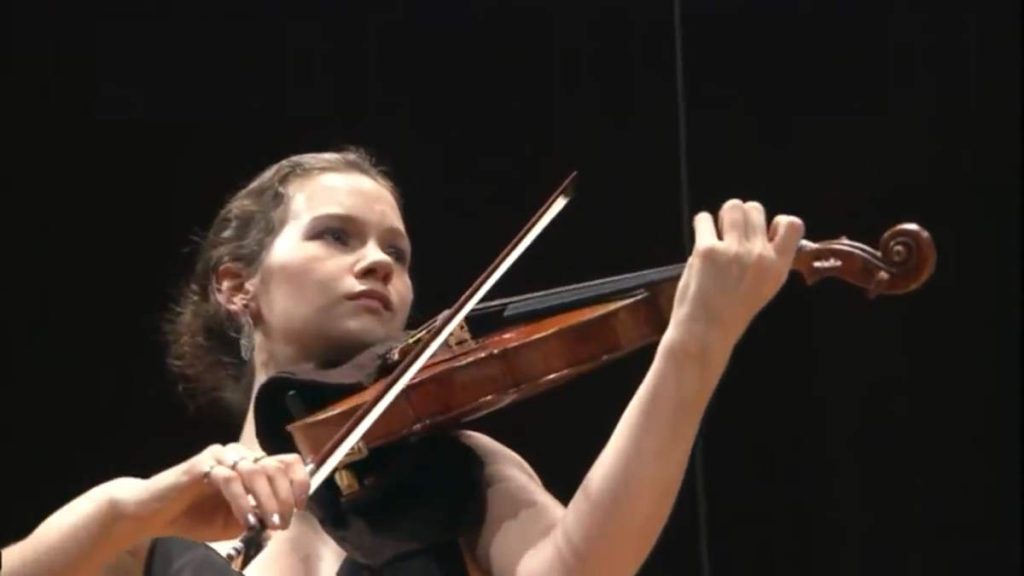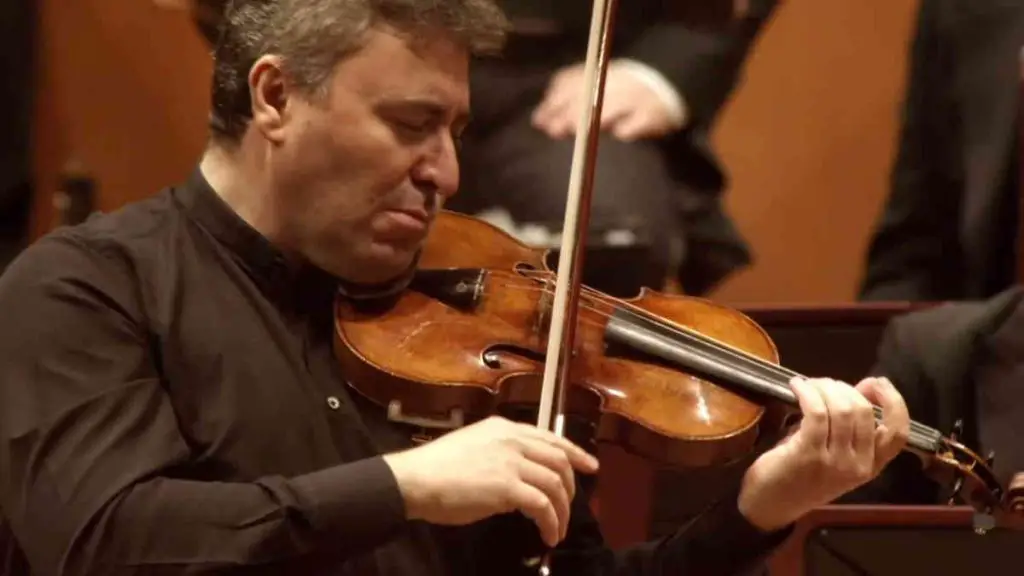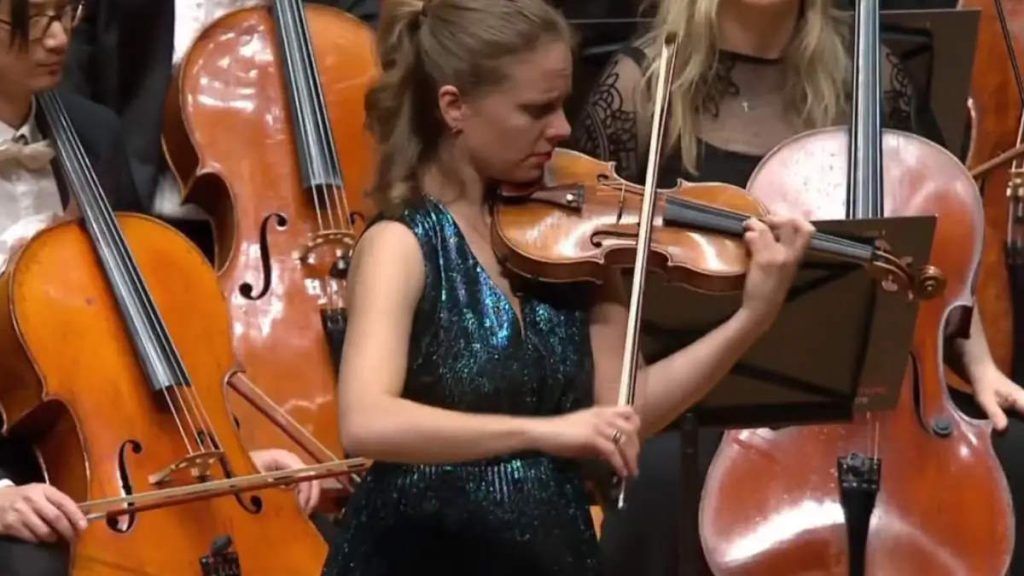Accompanied by the Orchestre Philharmonique de Radio France, the German violinist Julia Fischer plays Felix Mendelssohn’s Violin Concerto in E minor, Op. 64. Conductor: Myung-Whun Chung. Recorded during the Saint-Denis Festival on June 19, 2014. Encore: Sarabande, one of the Six Suites for Unaccompanied Cello by Johann Sebastian Bach.
Mendelssohn’s Violin Concerto
Mendelssohn’s Violin Concerto in E minor, Op. 64, is one of the most beloved works in the violin repertoire, celebrated for its lyrical beauty, technical brilliance, and emotional depth. Composed in 1844, it marked a significant evolution in the concerto form, blending the virtuosity expected of a soloist with rich orchestral textures that are fully integrated into the narrative of the piece.
Felix Mendelssohn, a prodigious talent and a leading composer of the early Romantic era, crafted this concerto with a keen sense of melody and a deep understanding of the violin’s expressive capabilities. From the very beginning, the solo violin takes center stage, bypassing the traditional orchestral introduction, and immediately engaging the listener with a theme that is both passionate and haunting.
The concerto is notable for its innovative structure and seamless transitions between sections, avoiding the typical pauses between movements. This continuous flow enhances the dramatic tension and emotional continuity, keeping the audience engrossed from start to finish. The orchestration is delicate and supportive, allowing the violin to shine while also creating a rich, harmonic backdrop that amplifies the work’s lyrical qualities.
Mendelssohn’s Violin Concerto remains a staple of the violin repertoire, revered for its balance of technical challenges and expressive depth. It is a piece that not only showcases the soloist’s skill but also speaks to the heart, making it a favorite among both performers and audiences alike.
Movements
1. Allegro molto appassionato (E minor)
The first movement of Mendelssohn’s Violin Concerto is a masterful blend of passion, lyricism, and innovation. Unconventionally, it begins with the solo violin immediately introducing the main theme, bypassing the traditional orchestral introduction. This bold opening captures the listener’s attention right away, setting the tone for a movement that is both intensely emotional and technically demanding.
The principal theme, introduced by the violin, is deeply expressive, characterized by its sweeping, lyrical lines. This theme is soon echoed by the orchestra, creating a rich interplay between the soloist and the ensemble. The movement is marked by Mendelssohn’s signature lightness of touch, even in its most intense passages. The violinist is tasked with intricate, virtuosic runs, rapid arpeggios, and delicate trills, all of which must be executed with a balance of precision and expressiveness.
Mendelssohn’s orchestration in this movement is particularly notable for its transparency and support of the soloist. The orchestra never overpowers the violin; instead, it complements and enhances the solo line, providing a dynamic and harmonic foundation that allows the soloist to soar.
One of the most innovative aspects of this movement is its seamless transition into the second movement. Mendelssohn links the movements without a break, maintaining the momentum and emotional continuity, which was a departure from the traditional concerto form of the time.
2. Andante (C major)
The second movement of Mendelssohn’s Violin Concerto is a beautifully crafted piece that contrasts the intensity of the first movement with its serene, lyrical qualities. This movement is often described as a “song without words,” a term that reflects its vocal-like, expressive melodies and its ability to convey deep emotion without the need for text.
Opening with a gentle, flowing melody introduced by the solo violin, the movement immediately creates a sense of calm and introspection. The theme is simple yet profoundly beautiful, characterized by its smooth, arching lines that evoke a sense of tenderness and warmth. The violin sings this melody with a delicate, almost vocal quality, allowing the music to resonate with a sense of intimacy and grace.
Mendelssohn’s orchestration in this movement is particularly delicate, with the orchestra providing a soft, supportive background that allows the violin to take center stage. The interplay between the soloist and the orchestra is subtle and refined, with the strings often mirroring the solo violin’s lines, creating a rich, unified sound that enhances the lyrical nature of the music.
As the movement progresses, the theme is developed and varied, with the violin exploring different registers and dynamic levels, yet always maintaining the movement’s overall sense of tranquility. The second movement serves as a lyrical interlude between the more dramatic outer movements, showcasing Mendelssohn’s gift for melody and his ability to create music that is both emotionally resonant and technically exquisite.
3. Allegretto non troppo – Allegro molto vivace (E major)
The third movement of Mendelssohn’s Violin Concerto is a vibrant and exhilarating conclusion to the work, filled with energy, joy, and technical brilliance. This movement is often described as a “rondo,” characterized by its lively, dance-like themes and its buoyant, effervescent spirit.
From the outset, the solo violin introduces a playful, light-hearted theme that immediately lifts the mood. This theme is nimble and spirited, showcasing the violinist’s agility and precision as they navigate rapid passages, intricate arpeggios, and sparkling staccato notes. The movement is marked by its quick tempo and rhythmic vitality, with Mendelssohn infusing the music with a sense of forward momentum that propels the listener toward a joyous conclusion.
The orchestra plays a crucial role in this movement, providing a lively and robust accompaniment that enhances the soloist’s playful melodies. The dialogue between the violin and the orchestra is dynamic and interactive, with the orchestra often echoing or complementing the soloist’s lines, creating a sense of musical conversation that adds to the movement’s overall charm.
Throughout the third movement, Mendelssohn expertly balances technical demands with expressive musicality. The violinist must not only demonstrate virtuosity but also convey the light-hearted, celebratory nature of the music. The movement builds to a thrilling climax, with the violin soaring over the orchestra in a final, jubilant flourish that brings the concerto to a triumphant close.
Julia Fischer
Julia Fischer (born 15 June 1983 in Munich, Germany) is a German classical violinist and pianist. Her mother, Viera Fischer (née Krenková), came from the German minority in Slovakia and immigrated from Košice, Slovakia (then Czechoslovakia), to the Federal Republic of Germany in 1972. Her father, Frank-Michael Fischer, a mathematician who was born in East Germany, moved in the same year from Eastern Saxony to West Germany.
She began her studies before her fourth birthday when she received her first violin lesson from Helge Thelen. A few months later she started studying the piano with her mother.

She began her formal violin education at the Leopold Mozart Conservatory in Augsburg under the tutelage of Lydia Dubrowskaya. At the age of nine, Julia Fischer was admitted to the Munich Academy of Music, where she continues to work with Ana Chumachenco.
Fischer is recognized worldwide for possessing a talent of uncommon ability and as an exceptionally gifted artist, reflected in the numerous awards and effusive reviews she has received for both her live performances and recordings, including being named “Artist of the Year” at The Gramophone Awards in 2007 and “Instrumentalist of the Year” at the 2009 MIDEM Classical Awards.
The Orchestre Philharmonique de Radio France is a French radio orchestra providing music for Radio France. It specializes in contemporary music and was founded in 1937.
Sources
- Violin Concerto (Mendelssohn) on Wikipedia
- Julia Fischer on Wikipedia
- Julia Fischer’s official website
![Mendelssohn: Violin Concerto [Julia Fischer]](https://andantemoderato.com/wp-content/uploads/2023/04/Julia-Fischer-Mendelssohn-Violin-Concerto-1024x572.jpg)


